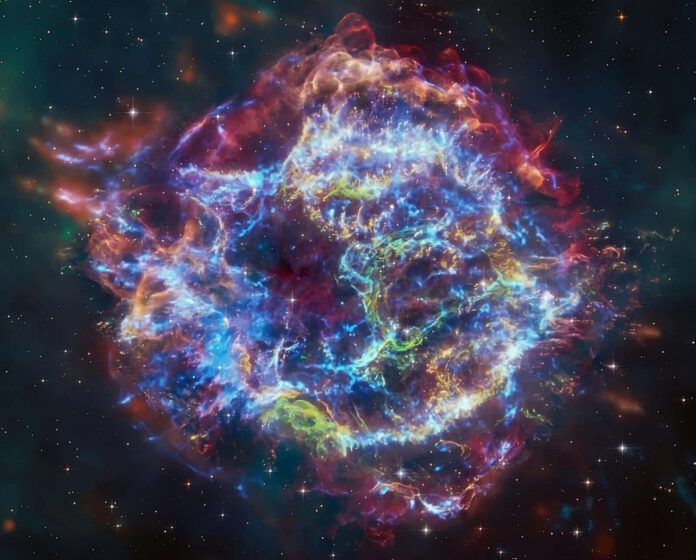
In the supernova remnant of the exploded star Cassiopeia A, green strands can be observed. Scientists have investigated whether this ‘green monster’ was created before or after the supernova explosion.
The Mysterious Green Strands in Cassiopeia A
Cassiopeia A (or Cas A for short) is located approximately 11,000 light years away in the Cassiopeia constellation. Roughly 340 years ago, a rare supermassive star exploded, though this event was not visible to the naked eye from the surface of our planet due to the star being shrouded in large amounts of gas and dust. The supernova remnant, Cassiopeia A, was only discovered in 1947, and it has since become one of the most studied remnants in the universe. Various space telescopes have captured images of this cosmic fireworks show. Earlier this year, the James Webb Telescope took a stunning new photo of Cassiopeia A, with astronomers observing the green strands in the supernova remnant’s heart for the first time.
Research into the Origins of the Green Monster
Recently, astronomers have analysed data from various telescopes, such as infrared data from the James Webb Telescope and X-ray data from the Chandra X-ray Telescope. The analysis reveals that the green structure already existed before the star exploded. In addition, the so-called green monster is moving in our direction. It’s likely that the structure was formed due to a temporary increase in gas that was blown away from the star.
“The green monster is, therefore, at the front of Cassiopeia A,” explains Jacco Vink from the University of Amsterdam. “However, the monster appears to be in the center of the image. This is a kind of illusion,” Vink adds. “In other words, the green monster is photobombing the central part of Cassiopeia A,” adds co-author Ilse De Looze from Ghent University.
The Green Monster: An Unusual Moniker
The green monster in Cassiopeia A shares its name with the famous eleven-meter-high green wall in Boston Red Sox’s baseball stadium. The 94-meter-long wall has stood since 1912, but it wasn’t painted green until 1947. With the wall’s imposing height, homeruns are rarely hit — instead, many balls bounce back into the playing field.
Continuing Studies of Cassiopeia A
Scientists are fascinated by the discovery of the green monster’s origin. Cassiopeia A is now one of the favored subjects of study among astronomers. In 2010, astronomers created a three-dimensional map of Cassiopeia A, and in 2022, they discovered that part of the material left after the supernova explosion was moving inward, not outward. The nebula is expanding at a speed of between 4,000 to 6,000 kilometers per second and is now sixteen light years in size. At the center of the nebula is a compact object, which could potentially be a black hole or a neutron star.











